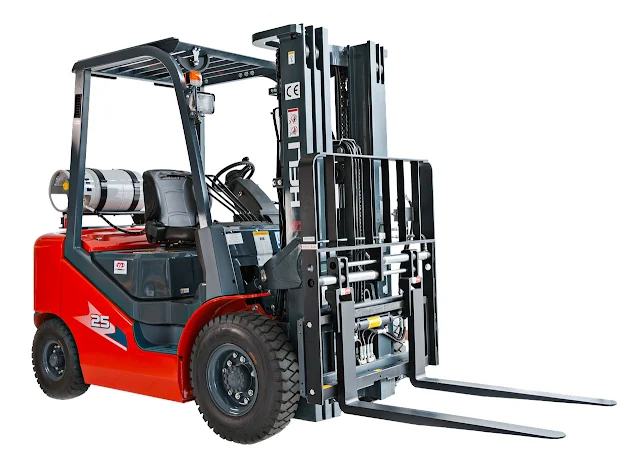Ad Code
Translate
List of 6,000+ Dofollow Commentluv Blogs FREE (Updated 2025)
January 16, 2025
What is Ozempic (semaglutide)? (Updated in 2025)
January 30, 2025
How To Find Suitable Properties In Cyprus? (Updated in 2025)
January 11, 2025
Smart strategies for trading on crypto exchanges
February 18, 2025
The Significance of Forklifts and Warning Lights for Forklifts
Khabza Mkhize
August 02, 2023

Forklifts have revolutionized how industries operate by enabling efficient and effective material handling. These powerful machines are a cornerstone of modern logistics and warehouse management, contributing to increased productivity and streamlined operations. However, the process of forklifts comes with inherent risks that must be managed diligently. This is where the significance of warning lights for forklifts becomes paramount, as they play a crucial role in ensuring the safety of operators and pedestrians in the vicinity.
In conclusion, the significance of forklifts and warning lights in the industrial landscape cannot be overstated. Forklifts are essential workhorses that drive the logistics and material handling sectors, but their safe operation is paramount. Warning lights are a pivotal tool in ensuring the well-being of operators and pedestrians and the efficient functioning of the workplace. These lights contribute to a safer, more productive, and harmonious work environment by preventing accidents, enhancing visibility, and promoting compliance. As technology continues to evolve, we can expect further innovations in warning light design, ultimately making workplaces even safer for everyone involved.
Enhancing Safety Through Warning Lights
Forklifts are known for their robustness and capability to easily lift and transport heavy loads. However, their sheer power can also be dangerous if not properly managed. Warning lights on forklifts serve as an essential visual communication tool that alerts others to the presence and movement of these machines. These lights come in various forms, including strobes, LED beacons, and spotlights designed for specific scenarios. For further insights, find out here and discover the perfect lighting solutions for your needs!1. Prevention of Accidents
One of the primary reasons for incorporating warning lights on forklifts is to prevent accidents. Forklifts often operate in bustling environments where there is a continuous flow of foot and vehicular traffic. By illuminating the immediate surroundings with highly visible lights, warning signals indicate the presence of a forklift and encourage others to exercise caution. This is particularly vital at blind corners, intersections, and loading docks where potential collisions are a concern.2. Pedestrian Safety
Pedestrians, including employees and visitors, share workspace with forklifts in many industrial settings. To ensure their safety, warning lights create a safety zone around the forklift, effectively delineating its operational area. The lights signal to pedestrians the restricted zone and prompt them to maintain a safe distance, minimizing the risk of accidents caused by inadvertent entry into the forklift's path.3. Enhanced Visibility
Forklifts often operate in environments with low visibility environments, such as dimly lit warehouses or outdoor yards at night. Warning lights dramatically improve the visibility of forklifts in such conditions. The bright and attention-grabbing lights cut through the darkness, making the forklift easily identifiable from a distance. This is particularly crucial when operating in areas with limited natural light or adverse weather conditions.4. Compliance and Regulations
Many regulatory bodies mandate warning lights on forklifts as part of occupational health and safety regulations. Adhering to these guidelines ensures compliance and demonstrates a commitment to creating a safe working environment for employees. Employers prioritizing safety through the proper use of warning lights establish trust and foster a culture of responsibility among their workforce.5. Prevention of Product and Infrastructure Damage
Forklifts are often responsible for transporting valuable and sometimes delicate cargo. Unintended collisions can damage goods, infrastructure, and the forklift itself. Warning lights aid operators in maneuvering safely, helping them avoid collisions with obstacles, racks, and other equipment, thus preserving the integrity of both the cargo and the facility.In conclusion, the significance of forklifts and warning lights in the industrial landscape cannot be overstated. Forklifts are essential workhorses that drive the logistics and material handling sectors, but their safe operation is paramount. Warning lights are a pivotal tool in ensuring the well-being of operators and pedestrians and the efficient functioning of the workplace. These lights contribute to a safer, more productive, and harmonious work environment by preventing accidents, enhancing visibility, and promoting compliance. As technology continues to evolve, we can expect further innovations in warning light design, ultimately making workplaces even safer for everyone involved.
Featured Post
12 Prominent new technologies and trends emerging in 2025
Khabza Mkhize-
April 02, 2025
Soapie Teasers
Sister Sites
Most Popular
List of 6,000+ Dofollow Commentluv Blogs FREE (Updated 2025)
January 16, 2025
Smart strategies for trading on crypto exchanges
February 18, 2025
Popular posts
List of 6,000+ Dofollow Commentluv Blogs FREE (Updated 2025)
January 16, 2025
Smart strategies for trading on crypto exchanges
February 18, 2025
Footer Menu Widget
Created By Blogspot Theme | Distributed By Gooyaabi Templates

0 Comments